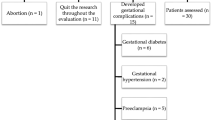Abstract
Purpose
The purpose of this study was the evaluation of total oxidant status (TOS), total antioxidant status (TAS), oxidative stress index (OSI) and superoxide dismutase (SOD) levels in women with threatened preterm labor (TPL) and also to compare the levels of these oxidative stress biomarkers of TPL pregnancies that had preterm and term deliveries.
Methods
This case–control study was conducted on 46 patients diagnosed with TPL and 47 healthy pregnant women matched for gestational age. Patients with threatened preterm labor were divided into two groups: true preterm birth (TPB) group (n = 16) and false preterm birth (FPB) group (n = 30) groups. Maternal serum SOD, TOS and TAS levels were measured by a spectrophotometric method using a commertial kit. OSI level for each patient was calculated by using the formula: (TOS (μmol·H2O2·equiv/L) × 100)/(TAS (μmol·Trolox·equiv/L)).
Results
The mean TAS levels of the TPB and FPB groups were significantly lower than those of the control group (0.96 ± 0.3 vs 1.36 ± 0.34, p1 < 0.001; 0.97 ± 0.22 vs 1.36 ± 0.34, p2 < 0.001, respectively). The mean SOD, TOS and OSI levels of the TPB and FPB groups were significantly higher than those of the control group (p < 0.001). There was no significant difference between the TPB and FPB groups for any oxidative stress biomarkers.
Conclusion
The maternal serum oxidative stress biomarkers are increased in pregnancies with TPL. However, these are not effective in predicting preterm birth in pregnancies with TPL.
Similar content being viewed by others
Data availability
The data that support the findings of this study are available from the corresponding author upon reasonable request.
References
Nour NM (2012) Premature delivery and the millennium development goal. Rev Obstet Gynecol 5:100–105
Frey HA, Klebanoff MA (2016) The epidemiology, etiology, and costs of preterm birth. Semin Fetal Neonat Med 21:68–73
Ananth CV, Ananth CV, Vintzileos AM (2006) Epidemiology of preterm birth and its clinical subtypes. J Matern Fetal Neonat Med 19:773–782
Moore TA, Ahmad IM, Zimmerman MC (2018) Oxidative stress and preterm birth: an integrative review. Biol Res Nurs 20:497–512
Martin A, Faes C, Debevec T et al (2018) Preterm birth and oxidative stress: effects of acute physical exercise and hypoxia physiological responses. Redox Biol 17:315–322
Joshi SR, Mehendale SS, Dangat KD et al (2008) High maternal plasma antioxidant concentrations associated with preterm delivery. Ann Nutr Metabol 53:276–282
O’Donovan DJ, Fernandes CJ (2004) Free radicals and diseases in premature infants. Antioxid Redox Signal 6:169–176
Goldenberg RL, Culhane JF, Iams JD, Romero R (2008) Epidemiology and causes of preterm birth. Lancet 371:75–84
Mathews TJ, MacDorman MF (2007) Infant mortality statistics from the 2004 period linked birth/infantdeath data set. Natl Vital Stat Rep 55:1–32
van Baaren GJ, Vis JY, Wilms FF et al (2014) Predictive value of cervical length measurement and fibronectin testing in threatened preterm labor. Obstet Gynecol 123:1185–1192
Romero R, Dey SK, Fisher SJ (2014) Preterm labor: one syndrome, many causes. Science 15(345):760–765
Romero R, Espinoza J, Gonçalves LF et al (2006) Inflammation in preterm and term labour and delivery. Semin Fetal Neonat Med 11:317–326
Eick SM, Ferguson KK, Milne GL et al (2020) Repeated measures of urinary oxidative stress biomarkers and preterm birth in Puerto Rico. Free Radic Biol Med 146:299–305
Arguelles S, Machado MJ, Ayala A et al (2006) Correlation between circulating biomarkers of oxidative stress of maternal and umbilical cord blood at birth. Free Radic Res 40:565–570
Grzesiak M, Gaj Z, Kocyłowski R et al (2018) Oxidative stress in women treated with atosiban for impending preterm birth. Oxid Med Cell Longev 2018:3919106
Weber D, Stuetz W, Bernhard W et al (2014) Oxidative stress markers and micronutrients in maternaland cord blood in relation to neonatal outcome. Eur J Clin Nutr 68:215–222
Jain SK, Wise R, Yanamandra K et al (2008) The effect of maternal and cord-blood vitamin C, vitamin E and lipid peroxide levels on newborn birth weight. Mol Cell Biochem 309:217–221
Funding
The authors have not disclosed any funding.
Author information
Authors and Affiliations
Contributions
All the authors contributed a lot to this research: K-HC: study design, data collection and writing; MÖ, HB: analysis and writing, AÖ: data collection and writing; E-AD: data collection, analysis and writing; DK: study design, data collection, analysis and writing; RM: study design, data collection, analysis and writing, data interpretation and revision of the draft.
Corresponding author
Ethics declarations
Conflicts of interest
The authors have no conflicts of interest relevant to this article.
Additional information
Publisher's Note
Springer Nature remains neutral with regard to jurisdictional claims in published maps and institutional affiliations.
Rights and permissions
Springer Nature or its licensor (e.g. a society or other partner) holds exclusive rights to this article under a publishing agreement with the author(s) or other rightsholder(s); author self-archiving of the accepted manuscript version of this article is solely governed by the terms of such publishing agreement and applicable law.
About this article
Cite this article
Hamzaoğlu Canbolat, K., Öncül, M., Özel, A. et al. Oxidative stress and antioxidant status in threatened preterm labor. Arch Gynecol Obstet 309, 1395–1400 (2024). https://doi.org/10.1007/s00404-023-07023-7
Received:
Accepted:
Published:
Issue Date:
DOI: https://doi.org/10.1007/s00404-023-07023-7




